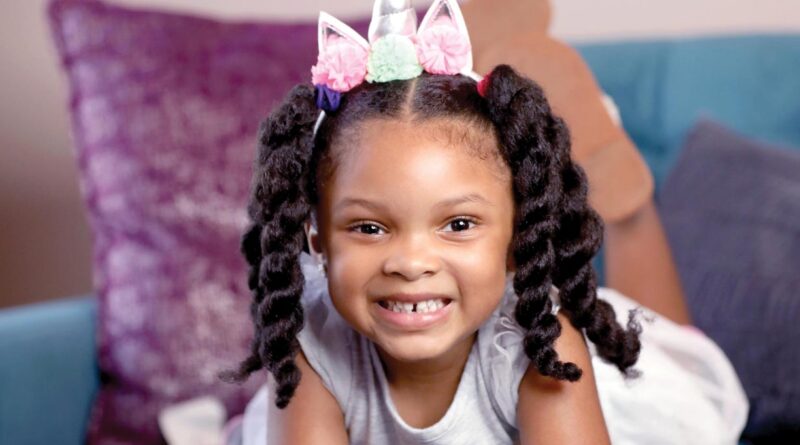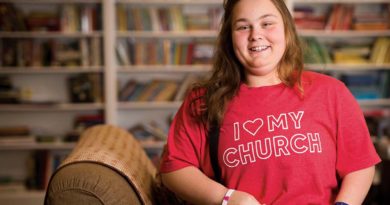Puzzle Pieces
Published on January 27th, 2021 by Christina Echegaray.
Kailani Brown was too quiet.
The normally spunky 4-year-old wasn’t talking her mother’s ear off or dancing through the house like usual after she finished her virtual pre-K classes. Her mother, Nicole Brown, found Kailani balled up under a blanket on the couch, asleep.
“It was a Friday, and I figured maybe she was just really tired at the end of the week,” Brown remembers.
Kailani slept fitfully through the rest of the day, and when her mother checked on her later, her temperature was just over 100 degrees.
It was the start of an illness that would send Kailani to the hospital, where she was diagnosed with a puzzling new disorder called multisystem inflammatory syndrome in children, or MIS-C.
MIS-C is a rare complication of COVID-19, and it’s part of a growing list of things we don’t yet understand about how COVID-19 is impacting children.
Here’s what we do know.
“In children, COVID-19 disease is much less severe than it has been in adults,” said Ritu Banerjee, MD, PhD, a pediatric infectious diseases specialist at Monroe Carell Jr. Children’s Hospital at Vanderbilt. “Of the first 900 or so COVID-infected children we’ve seen at Vanderbilt, 95% of them have remained outpatients who have recovered from their infections without any complications. A very small percentage, less than 5%, have required hospitalization, and among those only one patient who had multiple medical problems required mechanical ventilation.”
Despite the comforting news that most children and adolescents who become infected with SARS-CoV-2, the virus that causes COVID-19, have mild disease and recover quickly, it is clear that some children develop severe disease and rare complications like MIS-C, and researchers don’t know why.
“We continue to be surprised by COVID-19 every day. Just when we think we understand something, a new study comes out and we realize maybe we really don’t understand anything,” Banerjee said. “Why are some people completely asymptomatic and some get extremely sick? How susceptible are children to infection and how infectious are they? Are young children less infectious than older children? We really need more studies to answer those questions.”
Investigators at Children’s Hospital are highly engaged in local and national research efforts aimed at unpacking the mysteries of COVID-19. For example, they are entering cases of COVID-positive children into a national registry, collecting samples — nasal swab, saliva and blood — from pediatric patients and their family members to follow the disease, and collecting information to assess transmission in schools.
“There’s a lot of data gathering going on to try to learn more about this infection in children,” Banerjee said.
Sick for a month
Sarah Cook didn’t hesitate to enroll her family in studies at Vanderbilt after her son, Harrison, tested positive for SARS-CoV-2.
“I’m trying to teach them that it’s their civic duty, and this is how we learn about this disease,” Cook said.
Cook’s children, 15-year-old twins Harrison and Hallie and 13-year-old Janie, attended a two-week summer camp in Texas during July.
“We hesitated letting them go to the camp because of the infection rates, but we made an exception because the camp is so close to my heart — I went there — their cousins were going, and it’s essentially all outdoors, including the sleeping areas,” Cook said.
When she and her husband picked up their children, Cook knew with one look that Harrison wasn’t well. He told her that he’d had a sore throat and snotty nose, but no fever, for a couple of days. The girls felt fine, and the family completed the 13-hour drive home to Brentwood, Tennessee.
The next day, Harrison continued to blow his nose constantly and complained about being tired.
Sarah Cook got nervous. She had heard of some adolescents with only a runny nose having positive COVID tests, so she took Harrison to Vanderbilt for a test. It came back positive.

regain his strength. Photo by Erin O. Smith.
Harrison’s extreme fatigue and cold symptoms persisted for days, and then he developed weakness and pain in his legs, vomiting and severe diarrhea. In the meantime, Hallie started having cold symptoms and lung congestion, but her COVID test was negative, and she recovered after about 10 days. No one else in the family had symptoms.
After two weeks, Harrison started running a fever.
“It was bizarre,” Cook said. “The fever would come and go. He had extreme fatigue and could barely walk. I made him walk down the street and he complained of chest pain.”
Harrison, a water polo player who swam for two hours a day before he went to summer camp, was out of commission for a month. He’s back to practicing now and is lifting weights to regain his lost strength.
“Is he back to where he was? No. I think it takes a while to get back to normal after something like that,” Cook said.
Harrison says his friends were surprised that he couldn’t keep up his day-to-day activities.
“They didn’t realize how COVID can keep you in bed; that you can be really sick with it even if you don’t have to go to the hospital,” Harrison said. “It’s a real thing; I was sick with it for a month.”
Cook recognizes that most children and adolescents have mild disease, but “not everyone’s a two- or three-day cold type of thing,” she said. “It’s a weird virus; you can’t assume that someone’s not going to get hurt from this,” she added. “I saw it with my own eyes. Harrison’s at the peak of his health, has no underlying health conditions, was exercising every day…and he was barely able to stand up for a little while.”
Mostly mild disease…why?
The striking differences in response are intriguing to Natasha Halasa, MD, MPH, a pediatric infectious diseases specialist at Children’s Hospital.
“We would love to know and be able to predict how someone will respond,” she said. “Most children may get a slight fever or not feel so well for a few days. Of those that have severe disease, about half have an underlying medical condition. Like adults, if a child has asthma or obesity, they’re more likely to have more severe disease. But that leaves half of those who have severe disease without any underlying condition. Why is that?”
Investigators are exploring potential genetic differences that may put some people at risk for more severe disease.
Children who develop severe disease are treated with the same approaches and medications used for adults, which include steroids, supplemental oxygen, respiratory support and the antiviral remdesivir, Banerjee said. Researchers at Vanderbilt, including Mark Denison, MD, director of the Division of Pediatric Diseases and an international authority on coronaviruses, played a key role in the development of remdesivir, the first drug approved by the U.S. Food and Drug Administration for the treatment of COVID-19.
Halasa is leading a study aimed at the question of why children have mostly mild disease.
“This virus is fascinating because other respiratory viruses like RSV and influenza are most severe in children and the elderly, but this virus is mostly sparing the children,” Halasa said.
There is some evidence, she noted, that the cells lining the nasal passages in children have less of the receptor for SARS-CoV-2, called ACE2, compared to adults, making the virus less able to latch onto and infect cells in children. That might explain why only about 8% of COVID cases are in children, but it’s not the whole story, Halasa believes.
“We still see severe disease in children; children have died from COVID; children have suffered complications,” she said.
She and her team are enrolling children and adults with confirmed SARS-CoV-2 infection and their close contacts to follow over time. They are collecting nasal swab and blood samples to determine virus levels and immunological responses — both antibody responses and, in collaboration with Vanderbilt immunologist Spyros Kalams, MD, cellular immune responses. It is possible, Halasa said, that children and adults have different immune responses to SARS-CoV-2, which could help explain differences in disease severity.
Unplanned extubations in preterm infants studied
Every two weeks, families across the country pull out surveys and nasal swab kits. Read more »
So far, they have enrolled more than 700 individuals who have had confirmed or suspected infection and their household contacts in the study, called COPE (COVID Outbreak Pandemic Exploration). About one-third of the study participants are children, including 43 with confirmed SARS-CoV-2 infection.
Another study, funded by the Centers for Disease Control and Prevention (CDC) and led by Vanderbilt investigators Carlos Grijalva, MD, MPH, and H. Keipp Talbot, MD, MPH, enrolled some of the same families to examine the transmission of SARS-CoV-2 within households in Nashville. The team reported recently in the CDC’s Morbidity and Mortality Weekly Report that 51% of others living in a home with someone who was positive for COVID-19 also became infected, and quickly — within five days of the first person experiencing symptoms.
A scary complication
Although SARS-CoV-2 is a respiratory virus, it’s causing problems beyond the lungs and respiratory system, Halasa said. She noted that the ACE2 receptor is present throughout the body, which allows the virus to infect a wider range of tissues and organs.
“People are having long-term complications — pulmonary, cardiac, neurological — most of the complications we’re seeing associated with this virus are not what we see with other respiratory viruses,” Halasa said.
She notes that children are also suffering from similar complications, findings that have not yet been widely appreciated.
And then there’s the rare and unsettling inflammatory complication, MIS-C, which appears to be a dysregulation of the immune response that occurs two to four weeks after COVID-19 infection, even in children who were completely asymptomatic — like Kailani Brown.
Kailani hadn’t been ill before she started running a fever that Friday in late August 2020.
A rapid strep test at her pediatrician’s office was negative on Saturday, and results from a COVID-19 test wouldn’t be back for a few days. By Sunday, Kailani’s fever was so high that her mother took her to the Emergency Department at Children’s Hospital, where the clinicians suspected Kawasaki disease — an inflammatory syndrome with clinical symptoms of fever, rash, redness of the eyes, swollen lymph nodes and inflammation of the mouth, lips and throat.
But Kailani’s fever waned while she was in the emergency department, and Nicole Brown was advised that she could take Kailani home and bring her back for bloodwork and treatment if the fever persisted for two more days. The fever did persist, and on Tuesday, Kailani was admitted to the hospital with clearly swollen red lips and red eyes, Brown said.
“She didn’t want to eat or drink or get out of the bed. It was like she was off balance and didn’t want to put her feet to the ground,” Brown said.
Although her COVID-19 virus tests were negative, Kailani had antibodies in her blood, suggesting previous infection — a surprise to Nicole Brown, who said the family had been vigilant in staying at their Hermitage, Tennessee, home, not seeing other people and wearing masks when running errands. Brown’s husband, a delivery driver for Frito-Lay, even went so far as to strip off his clothes and go straight to the shower when he returned home from work each day, she said.
The evidence of COVID-19 infection and other clinical and laboratory features make MIS-C distinct from Kawasaki disease, despite overlap between the two syndromes, Banerjee explained. The treatment is similar and involves intravenous medications to modulate the immune system and calm the hyper-inflammation.
Kailani recovered and went home after one week. She will continue to be followed for a year through a multidisciplinary MIS-C clinic at Children’s Hospital where specialists from pediatric infectious diseases, rheumatology and cardiology monitor patients and look for complications.
“It was so scary, and it took her a while even after we came home to get back to being herself,” Brown said.
Banerjee stresses that MIS-C is rare. Tennessee has reported at least 50 cases of MIS-C to the CDC, while the state has had more than 110,750 cases of COVID-19 in children and youth up to age 20 as of early January. Children’s Hospital has treated 19 children for MIS-C since mid-July.
More than three-quarters of the 1,659 MIS-C cases in the United States, as of early January, were in children who are Black or Hispanic, according to the CDC, a troubling number that mirrors the racial and ethnic disparities of the pandemic overall, Banerjee noted.
“We have a lot of work to do to understand COVID-19 and complications like MIS-C,” Banerjee said. “Of course, the best way to prevent these complications is to prevent COVID-19 infection in the first place. We all need to be masking, physically distancing, washing our hands and avoiding large gatherings.”
—by Leigh MacMillan
Hope – Winter 2021




